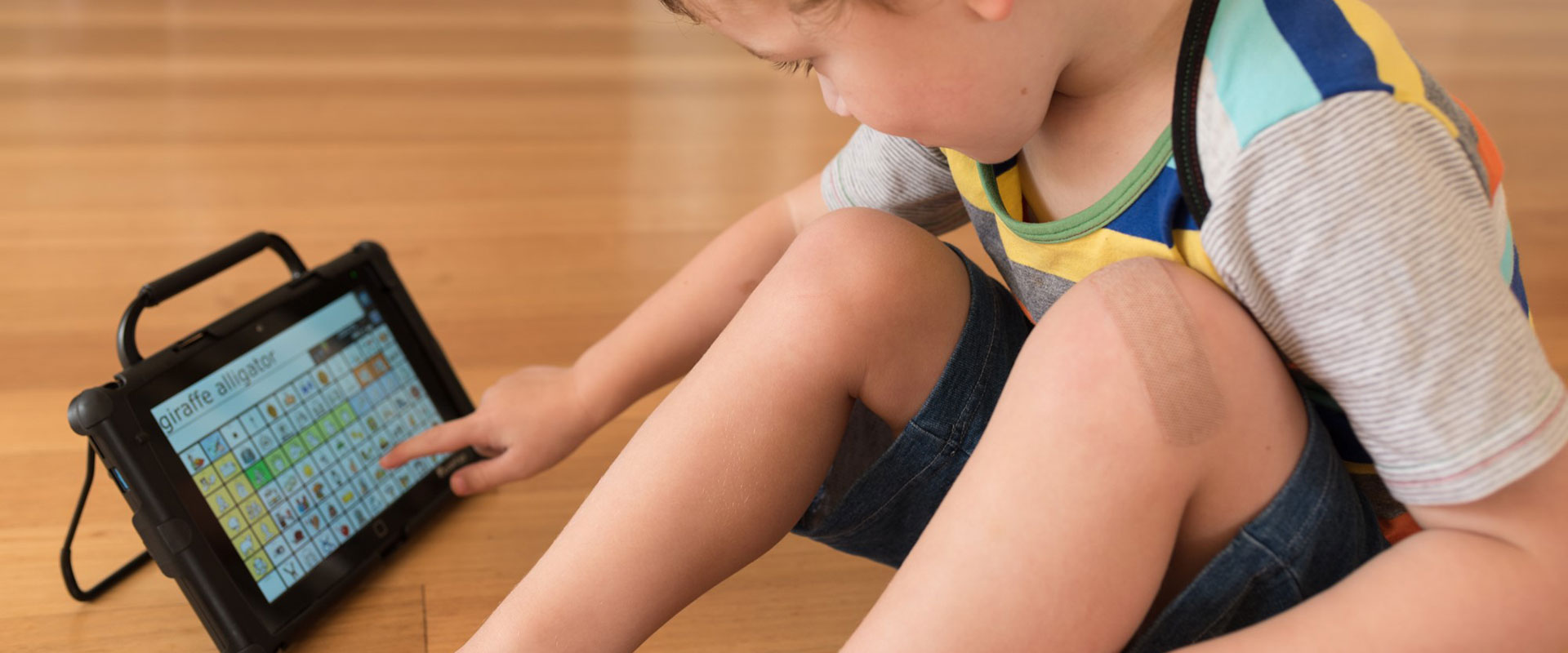AAC in the classroom: How do we use the device?

Education staff play an important role in teaching language and encouraging communication. For students, a school day is ripe with opportunities for learning language, new concepts, social skills and a chance to further develop their individuality.
AAC in the classroom: How do we use the device?
So how can we encourage and support use of a device in classroom activities?
First and foremost, we need to be good communication partners. There are many things that we can do in the classroom to foster language growth in our AAC users. Below are some examples relevant for classroom support, and more general tips & resources can be found in our recent blog Top Tips for Communication Partners.
- Make sure the device is available and charged at all times (this may involve setting clear roles & responsibilities for different communication partners).
- Know the vocabulary on the student’s device so you can provide clear models in context. Seeing an AAC system used in real situations, by real people, for real reasons, is incredibly powerful.
- Accept all forms of communication (gesture, eye contact, vocalizations, body language) and don’t force your student to “say it on the device”. Instead, show them that you’ve understood and if practical, model on the device.
- Teach concepts before you test them. Provide some opportunities for errorless learning, provide natural consequences to what has been said on the device and repeat & generalise these concepts and words across activities. We need to consider that an AAC user needs the chance to learn how to use their system firstly to learn language & communicate, and secondly how to engage in learning tasks.
- Modify teaching activities based on your student’s needs and language abilities.
Modifying teaching activities and incorporating device use in the classroom can be a big and daunting task. Let’s break it down into 3 steps.
- Pick your words
- Review your icons
- Communicate
PRC is also the abbreviation for Liberator’s own parent company, the Prentke Romich Company. This breakdown of steps will help you to choose target vocabulary and provide some options for you to create supporting resources so you can foster communication with your AAC user in classroom activities. These steps and the following information have been adapted from the free PRC On Demand training Teaching Language in the Classroom: Speaking, Reading & Writing with AAC.
P - Pick your words
There are multiple ways that you can ‘pick your words’. You could choose them based on an activity, on IEP goals/curriculum tasks, on word lists or functions of communication, or a combination of all of the above.
- Activity based words
- Pick vocabulary based on words commonly used by other students doing the same activity. Adjust these words & grammar parts to match the language appropriate for the level your AAC user is at.
- IEP/curriculum-based words
- Are your AAC user’s goals around using subject-verb agreement, number concepts, particular morphological endings, prepositions, 2 word phrases? Keep these in mind as you choose your targets and adapt them to your planned activities.
- Word lists
- There are many word lists that may be relevant for your AAC user including; Top Words Used by Toddlers (Banajee, DiCarlo & Buras-Stricklin 2003) adapted in Gail Van Tatenhove’s top 300 Clinical List of Core Vocabulary or high frequency/sight word lists used by your school.
- Words based on language function
- Is your AAC user great at requesting but has difficulties with commenting or describing? Think about the language functions you’d like to build and make sure that your chosen vocabulary will allow for these.
- Combination
- Use any/all of these options together! Start with one and then check in with the other options to see if word targets have been overlooked.
Remember that a child who uses speech will independently select the words they wish to use from the vast array of words they hear/see used every day.
A child who uses AAC will independently select the words they wish to use from the vocabulary other people have chosen to model and, for aided symbols, made available for them to use (Porter & Kirkland, 1995).
R - Review your icons
Once you have decided on the target vocabulary, you now have to find their locations in the vocabulary system and familiarise yourself with them. This is a crucial step to allow you some stress-free modelling! Depending on which Liberator device you are using, there are different ways you can review these icons using our 3x built in supports.
- Word Finder (on device) allows you to search for the location of any word
- Using Word Finder on a LR8, Nova Chat (this also applies to older devices including the LR7 and Chat Fusion
- Using Word Finder on an Accent device
- Write with Icons/Capture feature (on computer software) allows you to make support materials with icon sequences. Once you have the icon sequences, let your imagination go wild in terms of resources you can create – bingo boards, flashcards, personalised books, PowerPoints, etc.
- Download the PASS free demonstration software if you are working with an Accent device user to use Write with Icons. This is only available on Windows/PC computers.
- Creating a smart chart and using write with icons in NuVoice (PASS)
- Download the Chat Editor free demonstration software if you are working with an LR8, Nova Chat or older LR7 or Chat Fusion device to use the Capture feature. This is only available on Windows/PC computers.
- Using the Capture feature in Chat Editor
- Vocabulary Builder (on device) allows you to restrict available vocabulary to have only target vocabulary available. You can use this with a student temporarily for a specific activity, or potentially for a longer period of time if they are a new user.
C – Communicate
Now that you have some options to choose target vocabulary, review icons and make necessary support materials, you are ready to encourage your AAC user to communicate in speaking, reading and writing activities. All three of these areas need to be considered for our AAC user’s success and opportunities given to allow them to become fluent communicators. Let’s look at an example of a show & tell activity.
Example activity: Show & Tell activity as part of the English unit of the Australian Curriculum in Foundation Year.
Example AAC user: currently using 1-3 word telegraphic phrases & sentences. The AAC user has brought in a seashell to show to the class.
Curriculum item ACELY1647 - Deliver short oral presentations to peers: share a personal experience, interest or discovery with peers in a semi-formal situation.
|
Pick your words |
Review your icons |
Communicate |
|
When thinking about activity-based words other students would use, we would need words to describe what the object is, where it came from, why the user likes it, what they do with it. Target phrases could include: · My favourite shell · Got at beach · Crab home · Pretty · Shiny · Look at it |
You could use vocabulary builder to mask other words not required for this presentation. You could also use write with icons/capture and print some visual supports.
|
Consider prompting the AAC user with specific questions/directions for them to be able to share their interest e.g. Tell us what you have there/What have you brought in to show us today?
Have visual supports available where required.
Make sure to consider any other communication partner strategies or prompting that you might need to help your user communicate. |
Remember, the best way to encourage AAC device use in classroom activities is to inject some FUN. Classroom AAC implementation can be daunting, but it can be as easy as P-R-C!
Resources
For additional information, resources & practical tips on aided language stimulation and modelling, see our previous blog post on Top Tips for Communication Partners.
For additional information on the ‘PRC framework’ for classroom use, watch the Teaching Language in the Classroom: Speaking, Reading & Writing with AAC.
Using a Device in the Classroom from the Center for AAC & Autism
The Do’s and Don’t’s of AAC Implementation
References
Porter, G. & Kirkland, J. (1995). Integrating Augmentative and Alternative Communication into Groups Programs: Utilising the Principles of Conductive Education. Melbourne, Australia: Spastic Society of Victoria.


